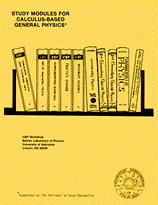Instructional Materials in Physics and Astronomy
Date of this Version
1975
Abstract
Imagine a bicycle rider coasting without pedaling along a road that is very smooth but has a lot of small hills. As he coasts up a hill, the force of gravity will, of course, slow him down; but it speeds him up again as he goes down the other side. We say that gravity is a conservative force because it gives back as much kinetic energy (KE) to the cyclist when he returns to a lower level, as it took away when he ascended to the top. We therefore assign a gravitational potential energy (PE) Ug to the cyclist, which depends only on his elevation. The lost kinetic energy is converted into this Ug. We then find to our delight that the sum E = K + Ug is (approximately) constant: Ug is larger at the top of each hill, and smaller at the bottom, in just such a way that its change compensates for the change in the kinetic energy K! This is an example of the conservation of mechanical energy.
However, if we watch the cyclist for some time, we are disappointed to find that K + Ug is only approximately conserved: frictional forces gradually slow the cyclist down; and after awhile he starts pedaling again, thereby increasing K + Ug. But still, all is not lost. The energy-conservation law can be saved by defining other kinds of energy (for example, chemical, thermal, and nuclear) that are produced by the action of so-called nonconservative forces. If we call these nonmechanical energy forms Enc, then E = K + U + Enc is exactly conserved. In fact, energy conservation is one of the great principles of physics, and one that holds even outside the domain where Newton's laws are valid.
Another example of energy transformation is provided by hydroelectric power production, beginning with the water stored behind a high dam. As the water rushes down the intake pipes it gains kinetic energy, then does work on the turbine blades to set them in motion; and, finally, the energy is transmitted electrically to appear as heat in the oven in your kitchen. Experience with energy transformations of this kind led to the formulation of the law of conservation of energy in the middle of the nineteenth century: ENERGY CAN BE TRANSFORMED, BUT NEITHER CREATED NOR DESTROYED. This law has survived many scientific and technological developments since that time, and our conception of the possible forms of energy has been enlarged. Whenever it seemed that energy was created or destroyed, physicists ultimately have been able to identify a new energy source (for example, thermonuclear energy in the sun) or a new energy receiver (such as neutrinos in beta decay).
In this module we shall be concerned only with mechanical energy and energy exchanged by doing work. We shall therefore be describing examples of mechanical energy conservation -- the case of the ideal bicycle rider, and nonconservation of mechanical energy -- the case of the real bicycle rider or the hydroelectric power plant. As a matter of fact, all practical, physically realizable phenomena involve friction, air resistance, and similar effects that result in some heating and a corresponding loss of mechanical energy. We shall therefore deal with idealized situations in which frictional forces are absent or are of a simple form. Since these forms of mechanical energy loss are often very small, our descriptions will be adequate approximations for many phenomena, and they will illustrate the law of conservation of energy as applied to mechanical processes.



Comments
From Study Modules for Calculus-Based General Physics
Copyright © 1975 CBP Workshop, University of Nebraska–Lincoln.
Reproduction rights granted.